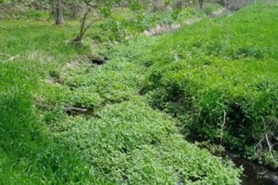Java Waterdropwort or Vietnamese parsley
(Oenanthe javanica)
Known by various names, Java water dropwort is often grown as a ground cover plant, particularly in wet soil areas or along ponds and streams. It spreads rapidly by sending out runners that quickly take root in moist soils.
Other names for this plant include:
- Common names: Japanese parsley, Chinese celery, water celery
- Scientific names: Oenanthe stolonifera
Classification in Wisconsin: Prohibited
- Ecological Threat
-
- If released in or adjacent to natural areas, this easily spreading ground cover plant can quickly move into wetlands and choke streams.
- Identification
-
Leaves: Lush green pinnate leaves resemble large flat parsley or celery foliage. A popular cultivar 'Flamingo' has white to pink edges to the leaves.
Flowers: Tiny white flowers bloom in umbels at the ends of stalks in late summer/early autumn.
Fruits & seeds: Similar to other carrot family members, they form tiny oval seeds at the top of the flowering stalks. Controlling the seed heads will not prevent this plant from spreading.
Roots: Fibrous roots can form from parts of a stem touching the ground or in water.
Stems: The jointed stems are hollow and often grow spreading along the ground. They are relatively brittle and can break off easily and take root.
Similar species: Very similar in appearance and habit to bishop's weed (Aegopodium podagraria), a similarly invasive ground cover plant. In general, there are many white-flowered look-alikes in the parsley family. One example is Queen Anne's lace (Daucus carota; non-native), a widespread weed in Wisconsin, with fern-like leaves, but leaves and stems are hairy. When crushed, it smells like carrots. Other look-alikes include wild chervil (Anthriscus sylvestris; invasive), caraway (Carum carvi; non-native), poison hemlock (Conium maculatum; invasive), Chinese hemlock parsley (Conioselinum chinense; native), native sweet cicely (Osmorhiza spp.).
- Distribution
-
See the reported locations of Java water dropwort in Wisconsin.
Do you know of other populations? Please send us a report.
- Control
-
Mechanical: Cutting is unlikely to be effective and may contribute to the spread of this plant as it can take root from stem fragments that contain nodes. Pulling small populations may work if all roots and stem fragments are collected and disposed of.
Chemical: Aquatic formulas of translocating herbicides may provide some control. Care should be taken to avoid spraying non-target vegetation and a permit may be required.
- Resources
- Sources for content:
- Efloras.org Flora of China - Oenanthe javanica [exit DNR].
- Stephens, J.M. 2018. Water Celery—Oenanthe javanica D.C. or O. stolonifera Wall. University of Florida, Horticultural Sciences Department, Florida Cooperative Extension Service, Institute of Food and Agricultural Sciences, Gainesville, FL.



